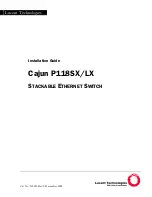
422
Managing PKI
Overview
The Public Key Infrastructure (PKI) offers an infrastructure for securing network services through public key
technologies and digital certificates, and for verifying the identities of the digital certificate owners.
A digital certificate is a binding of certificate owner identity information and a public key. Users can
obtain certificates, use certificates, and revoke certificates. By leveraging digital certificates and relevant
services such as certificate and blacklist distribution, PKI supports authenticating the entities involved in
communication, and guarantees the confidentiality, integrity, and non-repudiation of data.
PKI terms
Digital certificate
A digital certificate is a file signed by a certificate authority (CA) that contains a public key and the
related user identity information, such as an entity name and a digital signature from the CA. Typically,
a digital certificate also includes the validity period of the key, the name of the CA and the sequence
number of the certificate. A digital certificate must comply with the international standard of ITU-T_X.509.
This document involves local certificate and CA certificate. A local certificate is a digital certificate
signed by a CA for an entity. A CA certificate, also known as a "root certificate", is signed by the CA.
Certificate revocation list
An existing certificate might need to be revoked for different situations, for example, the username
changes, the private key leaks, or the user stops the business. Revoking a certificate will remove the
binding of the public key with the user identity information. In PKI, the revocation is made through
certificate revocation lists (CRLs). When a certificate is revoked, the CA publishes one or more CRLs to
show all certificates that have been revoked. The CRLs contain the serial numbers of all revoked
certificates and provide an effective method for checking the validity of certificates.
A CA might publish multiple CRLs when the number of revoked certificates is so large that publishing
them in a single CRL might degrade network performance.
CA policy
A CA policy is a set of criteria that a CA follows when processing certificate requests, issuing and
revoking certificates, and publishing CRLs. Usually, a CA advertises its policy in the form of certification
practice statement (CPS). A CA policy can be acquired through out-of-band means such as phone, disk,
and email. Because different CAs might use different methods to examine the binding of a public key
with an entity, make sure you understand the CA policy before selecting a trusted CA for certificate
request.
PKI architecture
A PKI system consists of entities, a CA, a registration authority (RA) and a PKI repository.
Summary of Contents for HP 830 Series
Page 37: ...25 Figure 18 Configuration complete ...
Page 70: ...58 Figure 49 Displaying the rate settings of ports ...
Page 78: ...66 Figure 56 Configuring the monitor port ...
Page 82: ...70 Figure 59 Switching to the management level ...
Page 87: ...75 Figure 64 Displaying port traffic statistics ...
Page 167: ...155 Figure 154 Displaying the current voice VLAN information ...
Page 304: ...292 Figure 280 Traceroute operation result ...
Page 321: ...309 Request timed out Ping statistics for 10 0 0 1 Packets Sent 4 Received 0 Lost 4 100 loss ...
Page 343: ...331 Figure 330 Ping operation summary ...
















































